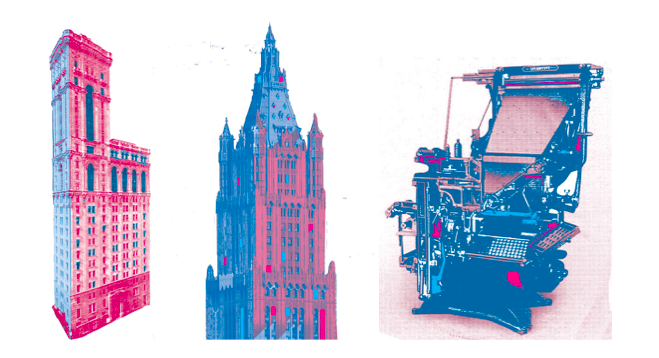
Cardboard backpacks worn by participants while chanting and walking in the streets of Little Syria
Through an historical tour of the neighborhood, and a visual spectacle comprised of costumes evoking early manhattan skyscrapers, Kahlil Gibran's drawings, and an odd linotype press, organizers hope to rekindle Little Syria's legacy in the minds of local historians and the Arab-American community.
"Shakib" represents the voice of tradition, recounting Little Syria's history and the accomplishments of its notable residents, such as the emergence of dozens of periodicals in the 1910's -20's because of the adaptation of the linotype printing press to Arabic, and The al-Mahjar literary movement, which included Rihani and Khalil Gibran, author of The Prophet. Shakib's history lesson is continually interrupted by Khalid, who reads humorous passages from Rihani's novel. Anti-hero Khalid challenges Shakib's nostalgia with the reality that hi-rise condos now stand where the neighborhood once flourished. Talk then turns to the fact that most of the community was evicted in the 1940's by an act of eminent domain in order to building the Brooklyn Battery Tunnel. One of the legendary Robert Moses' public works, his shadow on the Little Syria history is represented by the presence of imagery from the 1964 Worlds Fair, his most iconic project.
Little Syria Parade participants carried colorful prints of notable Lower manhattan buildings, all together evoking a walking, bouncing early-20th century NYC skyline as they traveled the streets of this forgotten community. This group of artists, activists, city historians, and preservationists participated in the city's smallest parade in hopes of reviving Little Syria's legacy in the minds of local historians and the Arab-American community alike, and also intended to raise awareness of the efforts to preserve the three remaining buildings from the old neighborhood.
The tour finished in front of the three buildings that remain of Little Syria; A church, a community center, and a tenement building. Together, these structures encapsulate the various spheres of daily life of the Levantine immigrant community in the early 20th-Century. Mary Ann Haick DiNapoli, historian, genealogist, and Municipal Arts Society tour guide, speaks to the crowd about the successful historic landmarking of St. George's Melkite Church by her group, Friends of the Lower West Side, and the very real danger facing the tenement and community center in the face of the city's redevelopment plans for the "Greenwich Street South" zone of Lower Manhattan.
Other participants then shared their personal connections to the community, notably Todd Fine, founder of the Washington Street Historical Society and Project Khalid, and Kim Charles Kay, an artist who is embedded in the Atlantic Avenue community in Brooklyn, the location where much of the Little Syria community resettled after the 1940's.
The cityscape in miniature then performed the feat of marching into St. George's Melkite Church, not to light a candle for the vanished community, but to sample the fare of the chinese restaurant the now inhabits the nave of the former Syrian church.
Filmmaker Husam Al-Sayed followed artist Brian Zegeer through the production of the Little Syria Parade, delving into the history of this vanished Lower-Manhattan community. From the 1880's through the 1940's Little Syria was the landing point for thousands of immigrants from Levant, Syria, Lebanon, and Palestine, a rich cultural center that produced dozens of newspapers for the growing diaspora community, recordings of traditional Arabic music, and a literary movement that included Kahlil Gibran, author of The Prophet. Most of the community was evicted in the late 1940's through an act of eminent domain for the construction of the Brooklyn Battery Tunnel.
SALAR and Ava Ansari in conversation with the co-prducers of Museum of The Mother Colony: Todd Fine, founding President of Washington Street Historical Society (WSHS) and founding director of Project Khalid and Brian Zegeer, Alpachian-Lebenese artist, relative of Ameen Rihani currently in residence at the Queens Museum, about their personal and professional connections to Little Syria.
"Little Syria", once a slum of tenement housing for first-generation Arab-American and Eastern-European immigrants, this lower-west-side Manhattan community was the launching point for thousands of immigrants pursuing prosperity across North America, the production site of periodicals and musical recordings disseminated throughout the World, and the literary movement of the "Al Mahjar" writers, who introduced free-verse to Arabic poetry, and a western audience to the voice of the Arabic lyrical tradition. Today the population is gone, the neighborhood remapped, yet another aspect of NYC's culture history erased. Developers include the geography that was once Little Syria in their plans for "Greenwich Street South" redevelopment.
Commissioned by Edge of Arabia #FREEWAY for The Armory Show 2015
Curated by Ava Ansari
Videography by Rachel Frank
Score: "Oort Cloud" by Baby Copperhead
Visit our Facebook Page
Follow us on Twitter
Follow us on Instagram
Visit our Youtube Channel
Visit our Tumblr profile
Visit our Instagram profile
×